A literature review on using the first language in a second or foreign language classroom
The paper seeks to review on the use of a first language or a mother tongue (L1) in a
second or foreign language (L2) classroom. The report examines permissible frequencies,
practical purposes and influential factors of the L1 employment in the L2 classrooms. The
findings provide that (i) there are mixed results of L1 use among novice and experienced
teachers or low-level and high-level students and among different language teaching approaches
followed by (ii) three main categorized reasons facilitating the role of L1. The review further
suggests strong factors influencing the use of L1, namely task types, proficiency levels, teaching
experience, timetabling, pedagogical tools, learning strategies, teachers’ beliefs and learners’
perceptions. The review closes with conclusion and classroom implications.
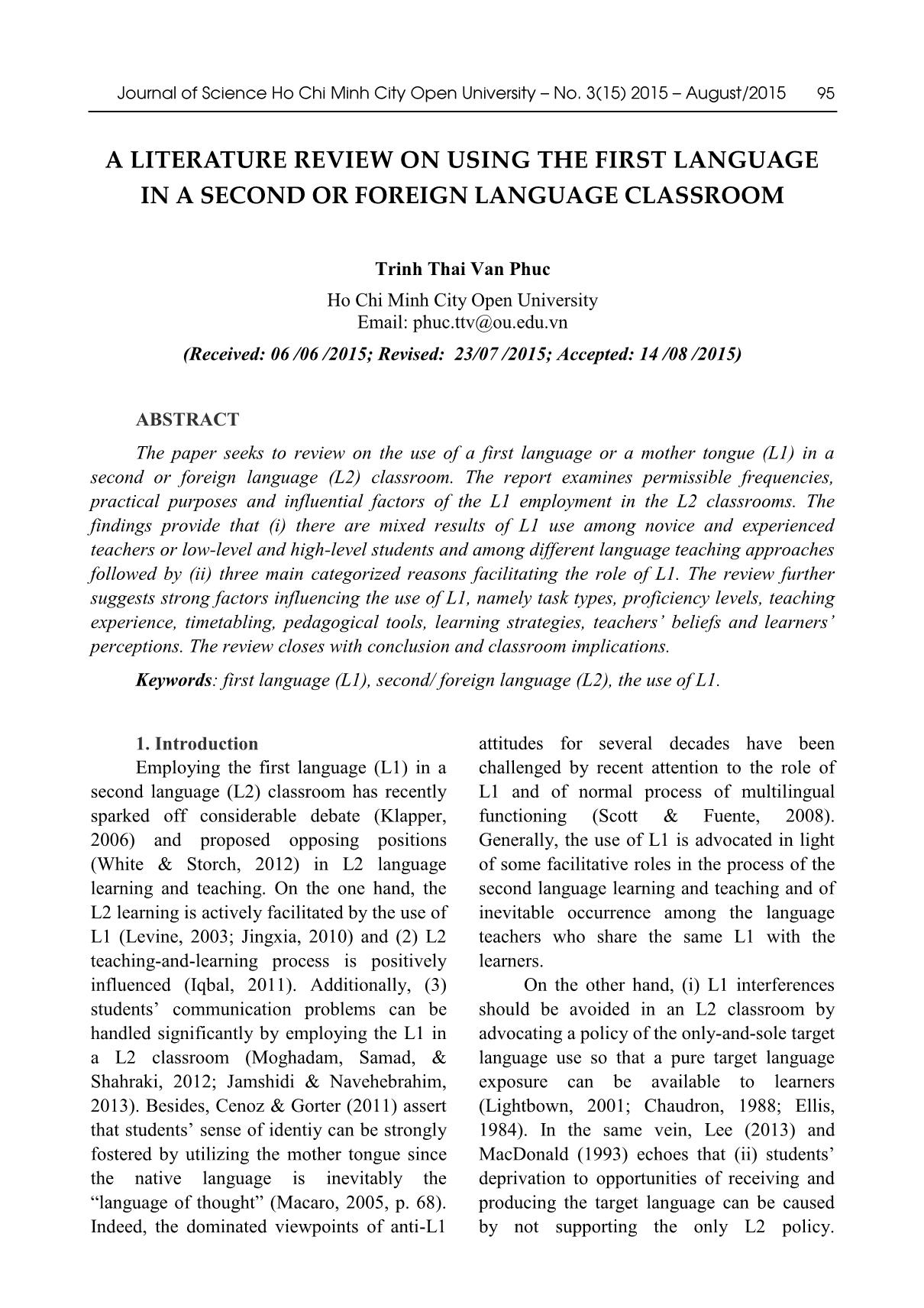
Trang 1
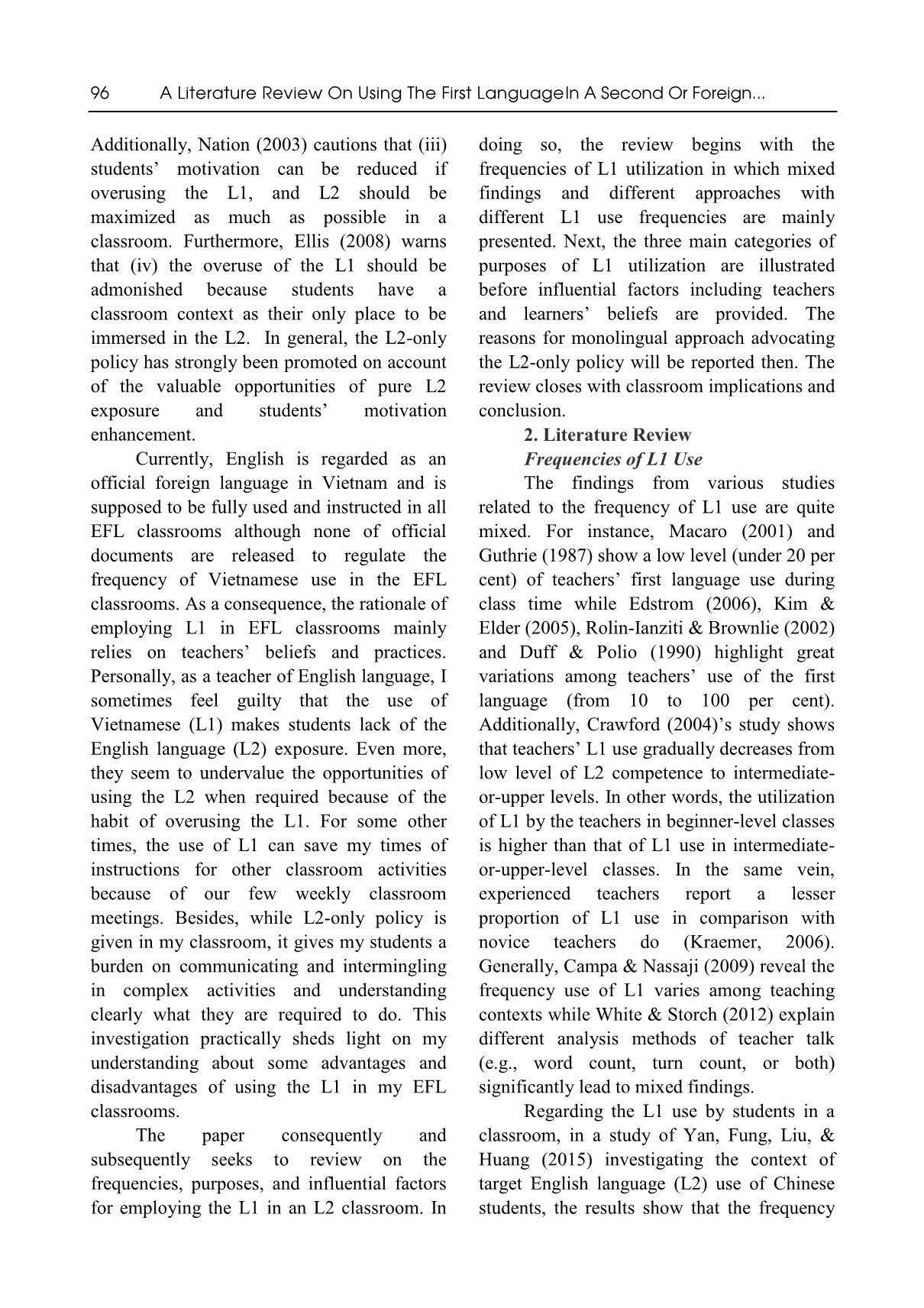
Trang 2
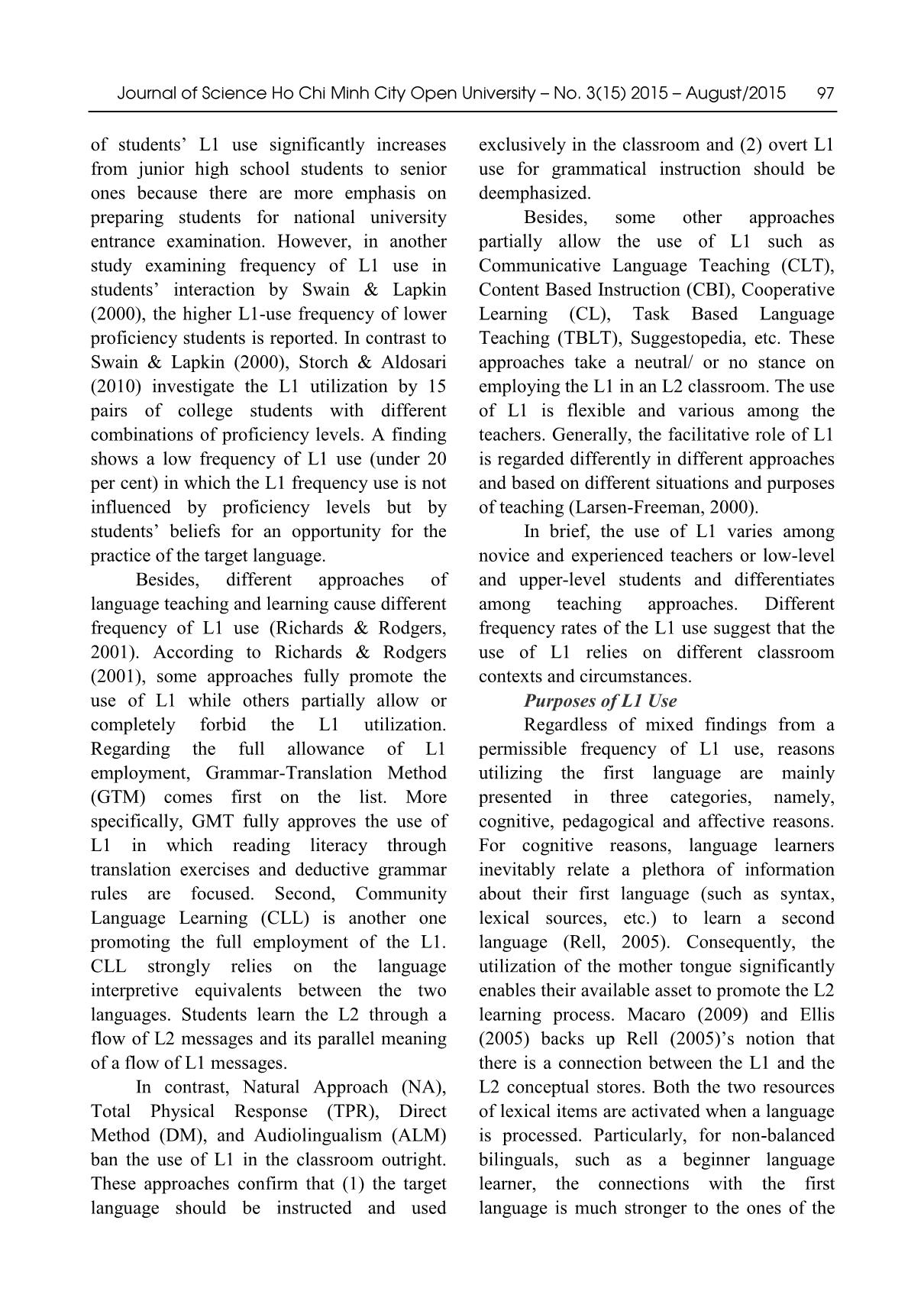
Trang 3
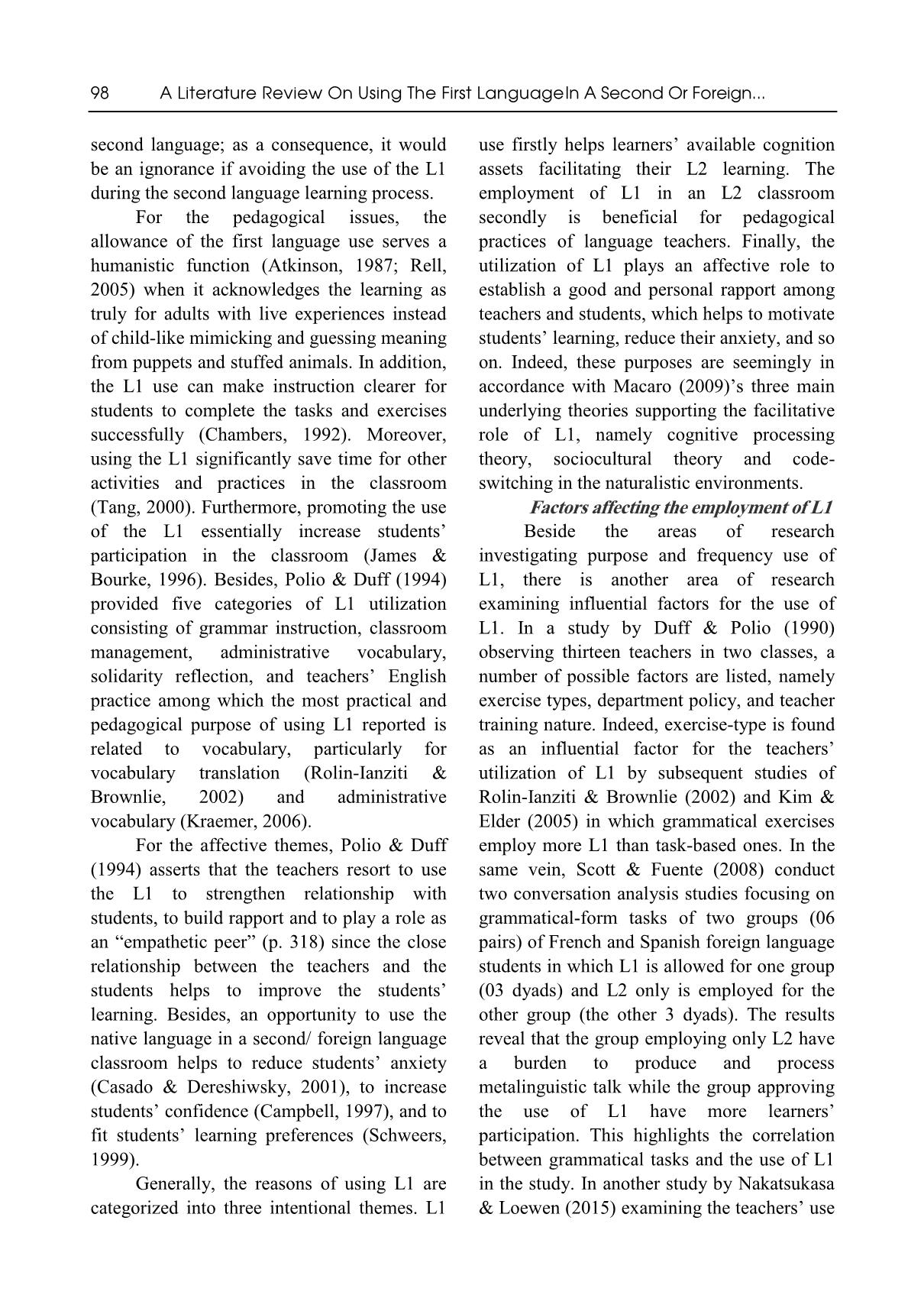
Trang 4
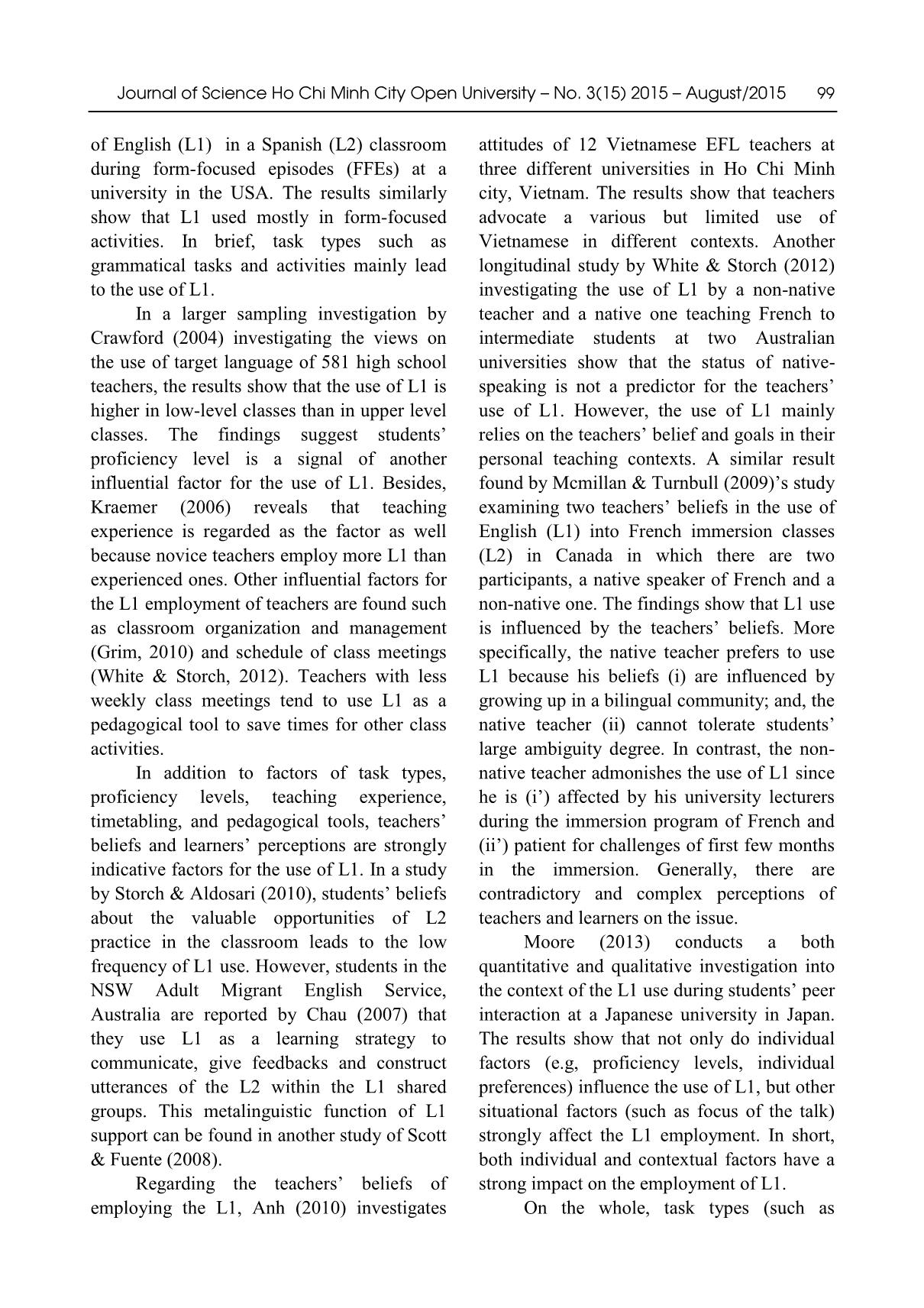
Trang 5
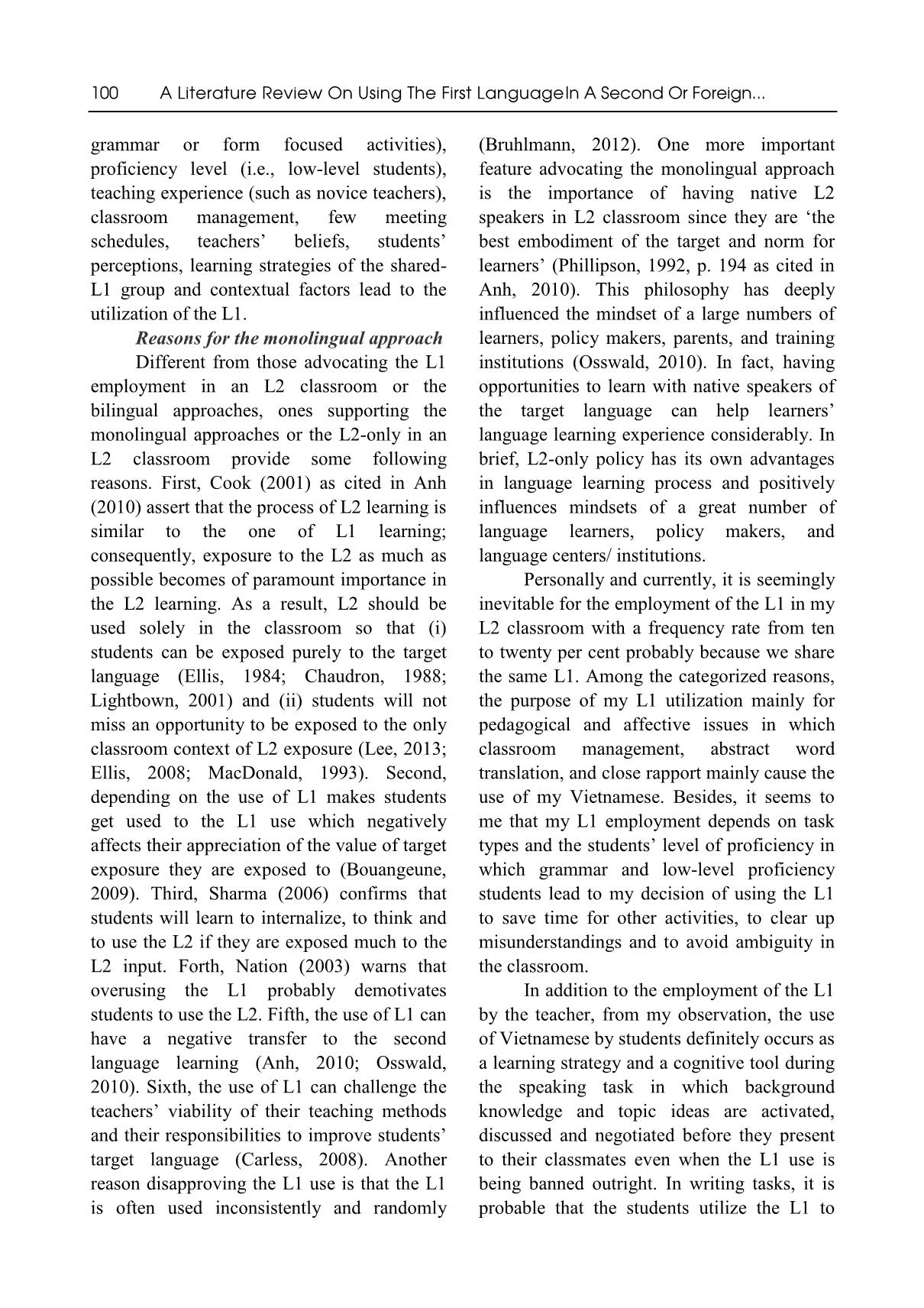
Trang 6
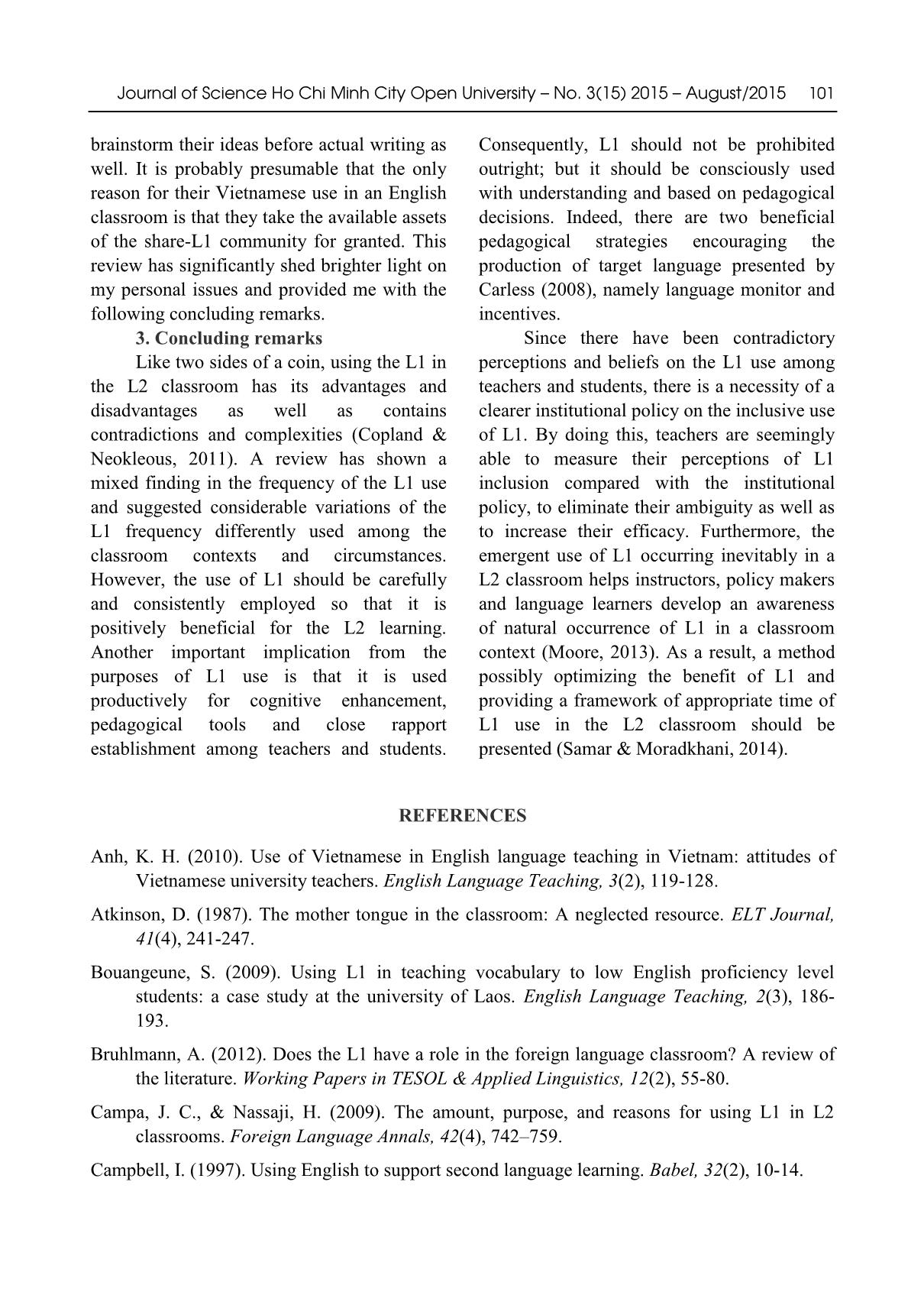
Trang 7
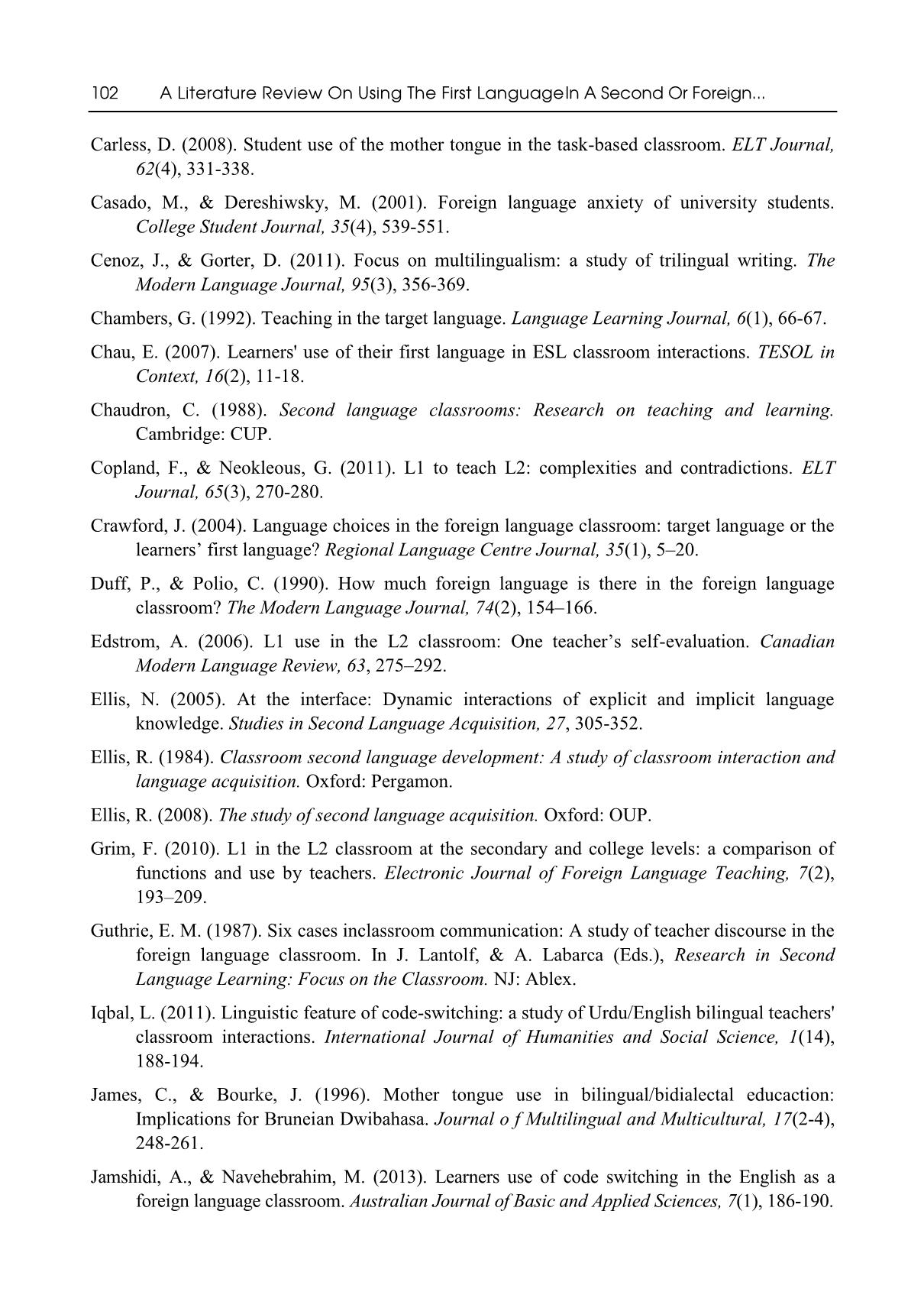
Trang 8
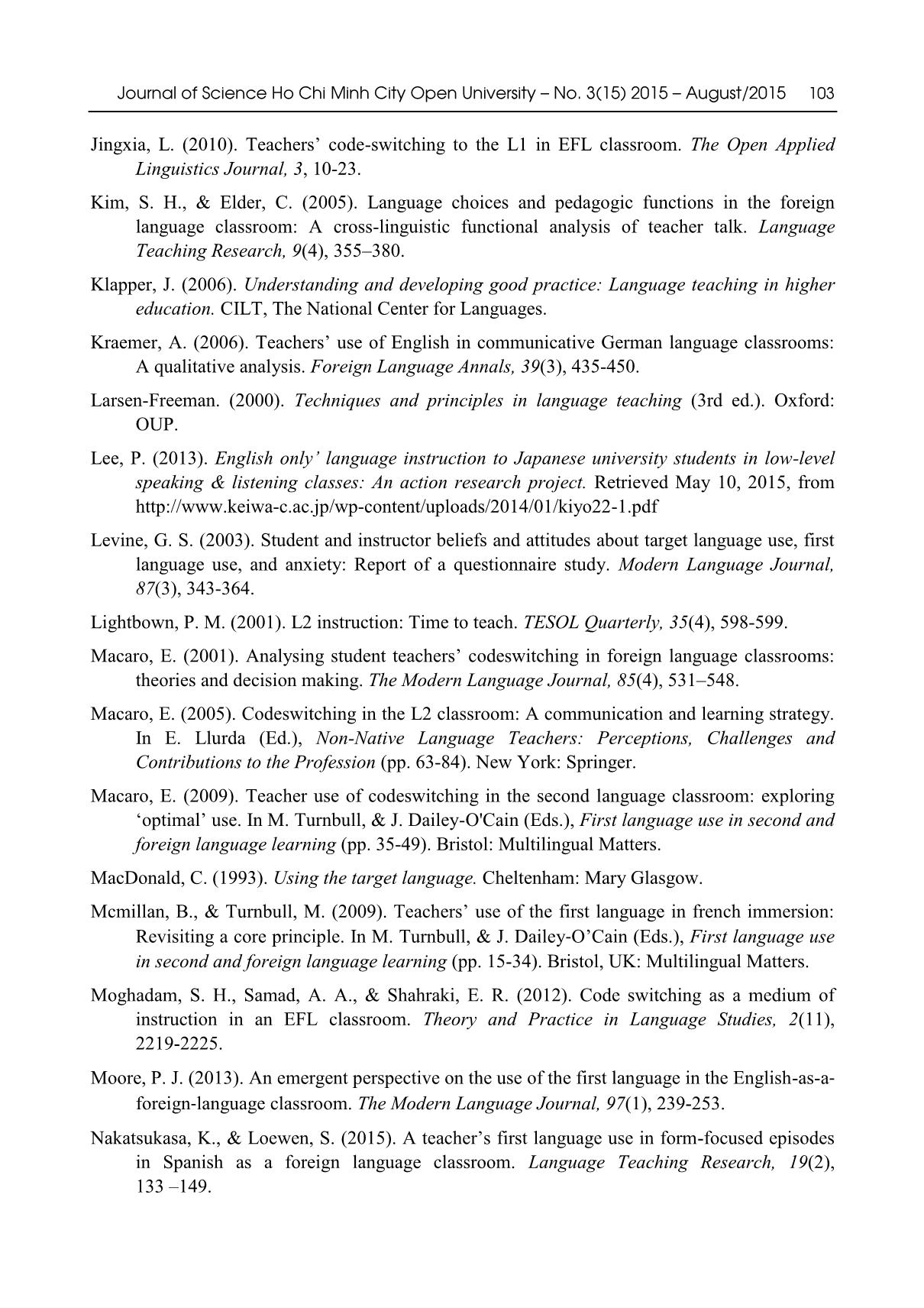
Trang 9
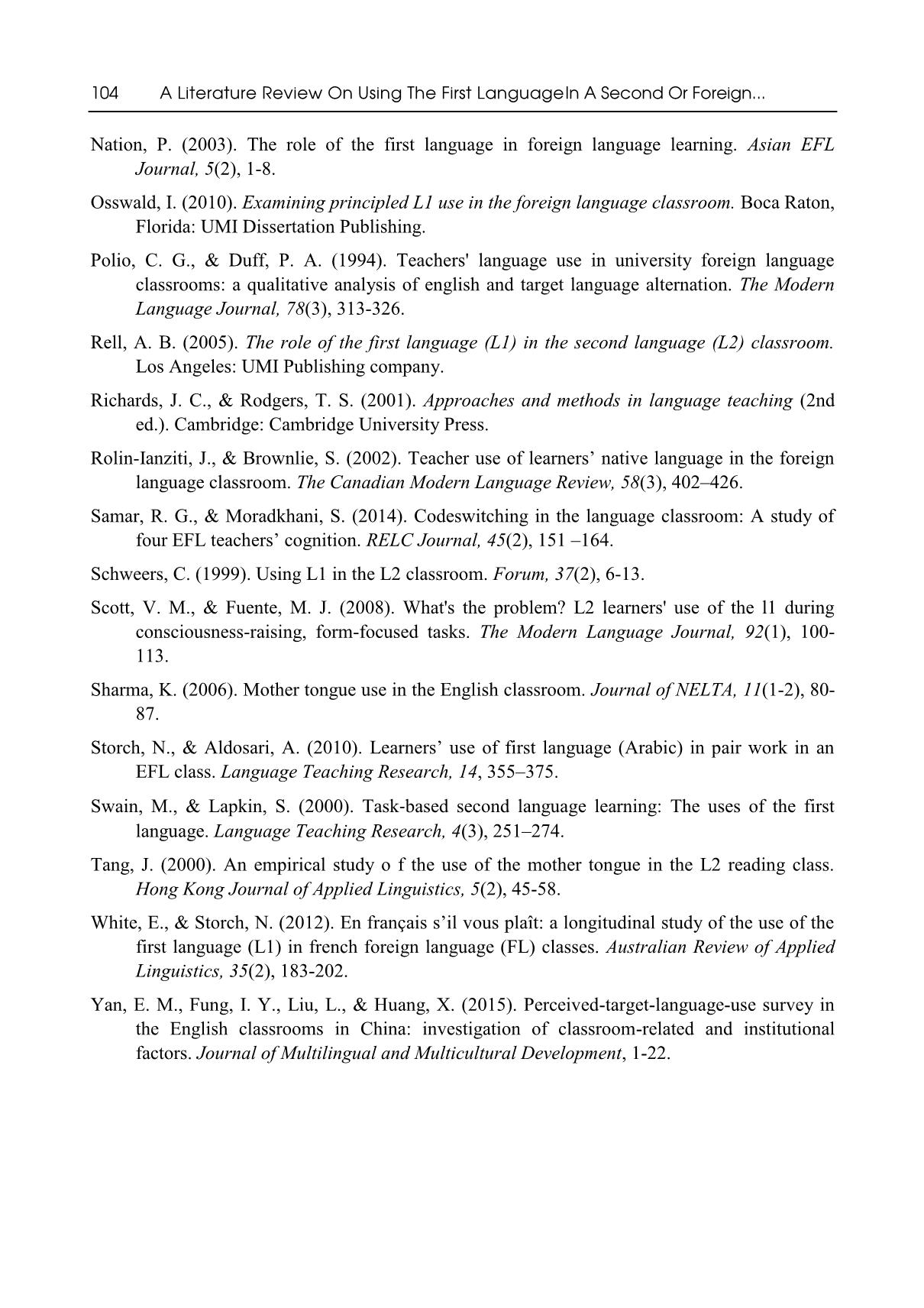
Trang 10
Tóm tắt nội dung tài liệu: A literature review on using the first language in a second or foreign language classroom
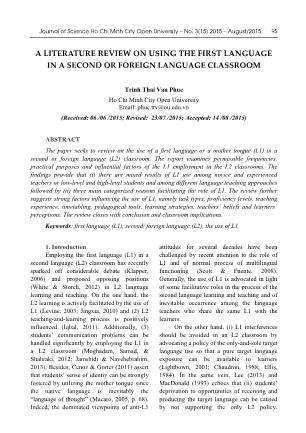
Journal of Science Ho Chi Minh City Open University – No. 3(15) 2015 – August/2015 95 A LITERATURE REVIEW ON USING THE FIRST LANGUAGE IN A SECOND OR FOREIGN LANGUAGE CLASSROOM Trinh Thai Van Phuc Ho Chi Minh City Open University Email: phuc.ttv@ou.edu.vn (Received: 06 /06 /2015; Revised: 23/07 /2015; Accepted: 14 /08 /2015) ABSTRACT The paper seeks to review on the use of a first language or a mother tongue (L1) in a second or foreign language (L2) classroom. The report examines permissible frequencies, practical purposes and influential factors of the L1 employment in the L2 classrooms. The findings provide that (i) there are mixed results of L1 use among novice and experienced teachers or low-level and high-level students and among different language teaching approaches followed by (ii) three main categorized reasons facilitating the role of L1. The review further suggests strong factors influencing the use of L1, namely task types, proficiency levels, teaching experience, timetabling, pedagogical tools, learning strategies, teachers’ beliefs and learners’ perceptions. The review closes with conclusion and classroom implications. Keywords: first language (L1), second/ foreign language (L2), the use of L1. 1. Introduction Employing the first language (L1) in a second language (L2) classroom has recently sparked off considerable debate (Klapper, 2006) and proposed opposing positions (White & Storch, 2012) in L2 language learning and teaching. On the one hand, the L2 learning is actively facilitated by the use of L1 (Levine, 2003; Jingxia, 2010) and (2) L2 teaching-and-learning process is positively influenced (Iqbal, 2011). Additionally, (3) students’ communication problems can be handled significantly by employing the L1 in a L2 classroom (Moghadam, Samad, & Shahraki, 2012; Jamshidi & Navehebrahim, 2013). Besides, Cenoz & Gorter (2011) assert that students’ sense of identiy can be strongly fostered by utilizing the mother tongue since the native language is inevitably the “language of thought” (Macaro, 2005, p. 68). Indeed, the dominated viewpoints of anti-L1 attitudes for several decades have been challenged by recent attention to the role of L1 and of normal process of multilingual functioning (Scott & Fuente, 2008). Generally, the use of L1 is advocated in light of some facilitative roles in the process of the second language learning and teaching and of inevitable occurrence among the language teachers who share the same L1 with the learners. On the other hand, (i) L1 interferences should be avoided in an L2 classroom by advocating a policy of the only-and-sole target language use so that a pure target language exposure can be available to learners (Lightbown, 2001; Chaudron, 1988; Ellis, 1984). In the same vein, Lee (2013) and MacDonald (1993) echoes that (ii) students’ deprivation to opportunities of receiving and producing the target language can be caused by not supporting the only L2 policy. 96 A Literature Review On Using The First LanguageIn A Second Or Foreign... Additionally, Nation (2003) cautions that (iii) students’ motivation can be reduced if overusing the L1, and L2 should be maximized as much as possible in a classroom. Furthermore, Ellis (2008) warns that (iv) the overuse of the L1 should be admonished because students have a classroom context as their only place to be immersed in the L2. In general, the L2-only policy has strongly been promoted on account of the valuable opportunities of pure L2 exposure and students’ motivation enhancement. Currently, English is regarded as an official foreign language in Vietnam and is supposed to be fully used and instructed in all EFL classrooms although none of official documents are released to regulate the frequency of Vietnamese use in the EFL classrooms. As a consequence, the rationale of employing L1 in EFL classrooms mainly relies on teachers’ beliefs and practices. Personally, as a teacher of English language, I sometimes feel guilty that the use of Vietnamese (L1) makes students lack of the English language (L2) exposure. Even more, they seem to undervalue the opportunities of using the L2 when required because of the habit of overusing the L1. For some other times, the use of L1 can save my times of instructions for other classroom activities because of our few weekly classroom meetings. Besides, while L2-only policy is given in my classroom, it gives my students a burden on communicating and intermingling in complex activities and understanding clearly what they are required to do. This investigation practically sheds light on my understanding about some advantages and disadvantages of using the L1 in my EFL classrooms. The paper consequently and subsequently seeks to review on the frequencies, purposes, and influential factors for employing the L1 in an L2 classroom. In doing so, the review begins with the frequencies of L1 utilization in which mixed findings and different approaches with different L1 use frequencies are mainly presented. Next, the three main categories of purposes of L1 utilization are illustrated before influential factors including teachers and learners’ beliefs are provided. The reasons for monolingual approach advocating the L2-only policy will be reported then. The review closes with classroom implications and conclusion. 2. Literature Review Frequencies of L1 Use The findings from various studies related to the frequency of L1 use are quite mixed. For instance, Macaro (2001) and Guthrie (1987) show a low level (under 20 per cent) of teachers’ first language use during class time while Edstrom (2006), Kim & Elder (2005), Rolin-Ianziti & Brownlie (2002) and Duff & Polio (1990) highlight great variations among teachers’ use of the first lang ... angeune, 2009). Third, Sharma (2006) confirms that students will learn to internalize, to think and to use the L2 if they are exposed much to the L2 input. Forth, Nation (2003) warns that overusing the L1 probably demotivates students to use the L2. Fifth, the use of L1 can have a negative transfer to the second language learning (Anh, 2010; Osswald, 2010). Sixth, the use of L1 can challenge the teachers’ viability of their teaching methods and their responsibilities to improve students’ target language (Carless, 2008). Another reason disapproving the L1 use is that the L1 is often used inconsistently and randomly (Bruhlmann, 2012). One more important feature advocating the monolingual approach is the importance of having native L2 speakers in L2 classroom since they are ‘the best embodiment of the target and norm for learners’ (Phillipson, 1992, p. 194 as cited in Anh, 2010). This philosophy has deeply influenced the mindset of a large numbers of learners, policy makers, parents, and training institutions (Osswald, 2010). In fact, having opportunities to learn with native speakers of the target language can help learners’ language learning experience considerably. In brief, L2-only policy has its own advantages in language learning process and positively influences mindsets of a great number of language learners, policy makers, and language centers/ institutions. Personally and currently, it is seemingly inevitable for the employment of the L1 in my L2 classroom with a frequency rate from ten to twenty per cent probably because we share the same L1. Among the categorized reasons, the purpose of my L1 utilization mainly for pedagogical and affective issues in which classroom management, abstract word translation, and close rapport mainly cause the use of my Vietnamese. Besides, it seems to me that my L1 employment depends on task types and the students’ level of proficiency in which grammar and low-level proficiency students lead to my decision of using the L1 to save time for other activities, to clear up misunderstandings and to avoid ambiguity in the classroom. In addition to the employment of the L1 by the teacher, from my observation, the use of Vietnamese by students definitely occurs as a learning strategy and a cognitive tool during the speaking task in which background knowledge and topic ideas are activated, discussed and negotiated before they present to their classmates even when the L1 use is being banned outright. In writing tasks, it is probable that the students utilize the L1 to Journal of Science Ho Chi Minh City Open University – No. 3(15) 2015 – August/2015 101 brainstorm their ideas before actual writing as well. It is probably presumable that the only reason for their Vietnamese use in an English classroom is that they take the available assets of the share-L1 community for granted. This review has significantly shed brighter light on my personal issues and provided me with the following concluding remarks. 3. Concluding remarks Like two sides of a coin, using the L1 in the L2 classroom has its advantages and disadvantages as well as contains contradictions and complexities (Copland & Neokleous, 2011). A review has shown a mixed finding in the frequency of the L1 use and suggested considerable variations of the L1 frequency differently used among the classroom contexts and circumstances. However, the use of L1 should be carefully and consistently employed so that it is positively beneficial for the L2 learning. Another important implication from the purposes of L1 use is that it is used productively for cognitive enhancement, pedagogical tools and close rapport establishment among teachers and students. Consequently, L1 should not be prohibited outright; but it should be consciously used with understanding and based on pedagogical decisions. Indeed, there are two beneficial pedagogical strategies encouraging the production of target language presented by Carless (2008), namely language monitor and incentives. Since there have been contradictory perceptions and beliefs on the L1 use among teachers and students, there is a necessity of a clearer institutional policy on the inclusive use of L1. By doing this, teachers are seemingly able to measure their perceptions of L1 inclusion compared with the institutional policy, to eliminate their ambiguity as well as to increase their efficacy. Furthermore, the emergent use of L1 occurring inevitably in a L2 classroom helps instructors, policy makers and language learners develop an awareness of natural occurrence of L1 in a classroom context (Moore, 2013). As a result, a method possibly optimizing the benefit of L1 and providing a framework of appropriate time of L1 use in the L2 classroom should be presented (Samar & Moradkhani, 2014). REFERENCES Anh, K. H. (2010). Use of Vietnamese in English language teaching in Vietnam: attitudes of Vietnamese university teachers. English Language Teaching, 3(2), 119-128. Atkinson, D. (1987). The mother tongue in the classroom: A neglected resource. ELT Journal, 41(4), 241-247. Bouangeune, S. (2009). Using L1 in teaching vocabulary to low English proficiency level students: a case study at the university of Laos. English Language Teaching, 2(3), 186- 193. Bruhlmann, A. (2012). Does the L1 have a role in the foreign language classroom? A review of the literature. Working Papers in TESOL & Applied Linguistics, 12(2), 55-80. Campa, J. C., & Nassaji, H. (2009). The amount, purpose, and reasons for using L1 in L2 classrooms. Foreign Language Annals, 42(4), 742–759. Campbell, I. (1997). Using English to support second language learning. Babel, 32(2), 10-14. 102 A Literature Review On Using The First LanguageIn A Second Or Foreign... Carless, D. (2008). Student use of the mother tongue in the task-based classroom. ELT Journal, 62(4), 331-338. Casado, M., & Dereshiwsky, M. (2001). Foreign language anxiety of university students. College Student Journal, 35(4), 539-551. Cenoz, J., & Gorter, D. (2011). Focus on multilingualism: a study of trilingual writing. The Modern Language Journal, 95(3), 356-369. Chambers, G. (1992). Teaching in the target language. Language Learning Journal, 6(1), 66-67. Chau, E. (2007). Learners' use of their first language in ESL classroom interactions. TESOL in Context, 16(2), 11-18. Chaudron, C. (1988). Second language classrooms: Research on teaching and learning. Cambridge: CUP. Copland, F., & Neokleous, G. (2011). L1 to teach L2: complexities and contradictions. ELT Journal, 65(3), 270-280. Crawford, J. (2004). Language choices in the foreign language classroom: target language or the learners’ first language? Regional Language Centre Journal, 35(1), 5–20. Duff, P., & Polio, C. (1990). How much foreign language is there in the foreign language classroom? The Modern Language Journal, 74(2), 154–166. Edstrom, A. (2006). L1 use in the L2 classroom: One teacher’s self-evaluation. Canadian Modern Language Review, 63, 275–292. Ellis, N. (2005). At the interface: Dynamic interactions of explicit and implicit language knowledge. Studies in Second Language Acquisition, 27, 305-352. Ellis, R. (1984). Classroom second language development: A study of classroom interaction and language acquisition. Oxford: Pergamon. Ellis, R. (2008). The study of second language acquisition. Oxford: OUP. Grim, F. (2010). L1 in the L2 classroom at the secondary and college levels: a comparison of functions and use by teachers. Electronic Journal of Foreign Language Teaching, 7(2), 193–209. Guthrie, E. M. (1987). Six cases inclassroom communication: A study of teacher discourse in the foreign language classroom. In J. Lantolf, & A. Labarca (Eds.), Research in Second Language Learning: Focus on the Classroom. NJ: Ablex. Iqbal, L. (2011). Linguistic feature of code-switching: a study of Urdu/English bilingual teachers' classroom interactions. International Journal of Humanities and Social Science, 1(14), 188-194. James, C., & Bourke, J. (1996). Mother tongue use in bilingual/bidialectal educaction: Implications for Bruneian Dwibahasa. Journal o f Multilingual and Multicultural, 17(2-4), 248-261. Jamshidi, A., & Navehebrahim, M. (2013). Learners use of code switching in the English as a foreign language classroom. Australian Journal of Basic and Applied Sciences, 7(1), 186-190. Journal of Science Ho Chi Minh City Open University – No. 3(15) 2015 – August/2015 103 Jingxia, L. (2010). Teachers’ code-switching to the L1 in EFL classroom. The Open Applied Linguistics Journal, 3, 10-23. Kim, S. H., & Elder, C. (2005). Language choices and pedagogic functions in the foreign language classroom: A cross-linguistic functional analysis of teacher talk. Language Teaching Research, 9(4), 355–380. Klapper, J. (2006). Understanding and developing good practice: Language teaching in higher education. CILT, The National Center for Languages. Kraemer, A. (2006). Teachers’ use of English in communicative German language classrooms: A qualitative analysis. Foreign Language Annals, 39(3), 435-450. Larsen-Freeman. (2000). Techniques and principles in language teaching (3rd ed.). Oxford: OUP. Lee, P. (2013). English only’ language instruction to Japanese university students in low-level speaking & listening classes: An action research project. Retrieved May 10, 2015, from Levine, G. S. (2003). Student and instructor beliefs and attitudes about target language use, first language use, and anxiety: Report of a questionnaire study. Modern Language Journal, 87(3), 343-364. Lightbown, P. M. (2001). L2 instruction: Time to teach. TESOL Quarterly, 35(4), 598-599. Macaro, E. (2001). Analysing student teachers’ codeswitching in foreign language classrooms: theories and decision making. The Modern Language Journal, 85(4), 531–548. Macaro, E. (2005). Codeswitching in the L2 classroom: A communication and learning strategy. In E. Llurda (Ed.), Non-Native Language Teachers: Perceptions, Challenges and Contributions to the Profession (pp. 63-84). New York: Springer. Macaro, E. (2009). Teacher use of codeswitching in the second language classroom: exploring ‘optimal’ use. In M. Turnbull, & J. Dailey-O'Cain (Eds.), First language use in second and foreign language learning (pp. 35-49). Bristol: Multilingual Matters. MacDonald, C. (1993). Using the target language. Cheltenham: Mary Glasgow. Mcmillan, B., & Turnbull, M. (2009). Teachers’ use of the first language in french immersion: Revisiting a core principle. In M. Turnbull, & J. Dailey‐O’Cain (Eds.), First language use in second and foreign language learning (pp. 15-34). Bristol, UK: Multilingual Matters. Moghadam, S. H., Samad, A. A., & Shahraki, E. R. (2012). Code switching as a medium of instruction in an EFL classroom. Theory and Practice in Language Studies, 2(11), 2219-2225. Moore, P. J. (2013). An emergent perspective on the use of the first language in the English-as-a‐ foreign‐language classroom. The Modern Language Journal, 97(1), 239-253. Nakatsukasa, K., & Loewen, S. (2015). A teacher’s first language use in form-focused episodes in Spanish as a foreign language classroom. Language Teaching Research, 19(2), 133 –149. 104 A Literature Review On Using The First LanguageIn A Second Or Foreign... Nation, P. (2003). The role of the first language in foreign language learning. Asian EFL Journal, 5(2), 1-8. Osswald, I. (2010). Examining principled L1 use in the foreign language classroom. Boca Raton, Florida: UMI Dissertation Publishing. Polio, C. G., & Duff, P. A. (1994). Teachers' language use in university foreign language classrooms: a qualitative analysis of english and target language alternation. The Modern Language Journal, 78(3), 313-326. Rell, A. B. (2005). The role of the first language (L1) in the second language (L2) classroom. Los Angeles: UMI Publishing company. Richards, J. C., & Rodgers, T. S. (2001). Approaches and methods in language teaching (2nd ed.). Cambridge: Cambridge University Press. Rolin-Ianziti, J., & Brownlie, S. (2002). Teacher use of learners’ native language in the foreign language classroom. The Canadian Modern Language Review, 58(3), 402–426. Samar, R. G., & Moradkhani, S. (2014). Codeswitching in the language classroom: A study of four EFL teachers’ cognition. RELC Journal, 45(2), 151 –164. Schweers, C. (1999). Using L1 in the L2 classroom. Forum, 37(2), 6-13. Scott, V. M., & Fuente, M. J. (2008). What's the problem? L2 learners' use of the l1 during consciousness-raising, form-focused tasks. The Modern Language Journal, 92(1), 100- 113. Sharma, K. (2006). Mother tongue use in the English classroom. Journal of NELTA, 11(1-2), 80- 87. Storch, N., & Aldosari, A. (2010). Learners’ use of first language (Arabic) in pair work in an EFL class. Language Teaching Research, 14, 355–375. Swain, M., & Lapkin, S. (2000). Task‐based second language learning: The uses of the first language. Language Teaching Research, 4(3), 251–274. Tang, J. (2000). An empirical study o f the use of the mother tongue in the L2 reading class. Hong Kong Journal of Applied Linguistics, 5(2), 45-58. White, E., & Storch, N. (2012). En français s’il vous plaît: a longitudinal study of the use of the first language (L1) in french foreign language (FL) classes. Australian Review of Applied Linguistics, 35(2), 183-202. Yan, E. M., Fung, I. Y., Liu, L., & Huang, X. (2015). Perceived-target-language-use survey in the English classrooms in China: investigation of classroom-related and institutional factors. Journal of Multilingual and Multicultural Development, 1-22.
File đính kèm:
 a_literature_review_on_using_the_first_language_in_a_second.pdf
a_literature_review_on_using_the_first_language_in_a_second.pdf

